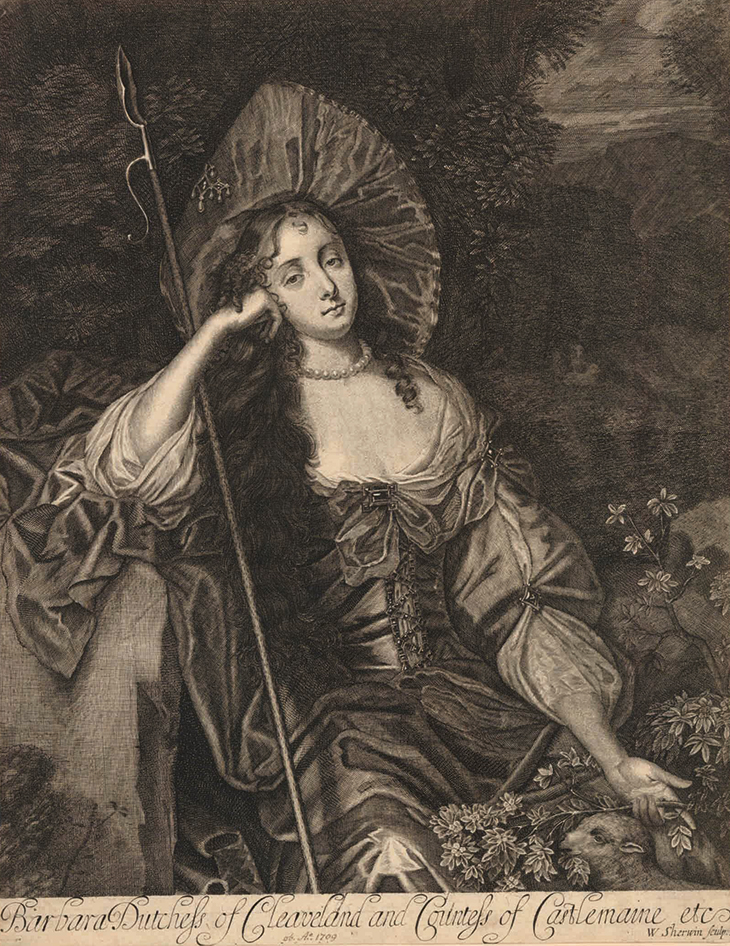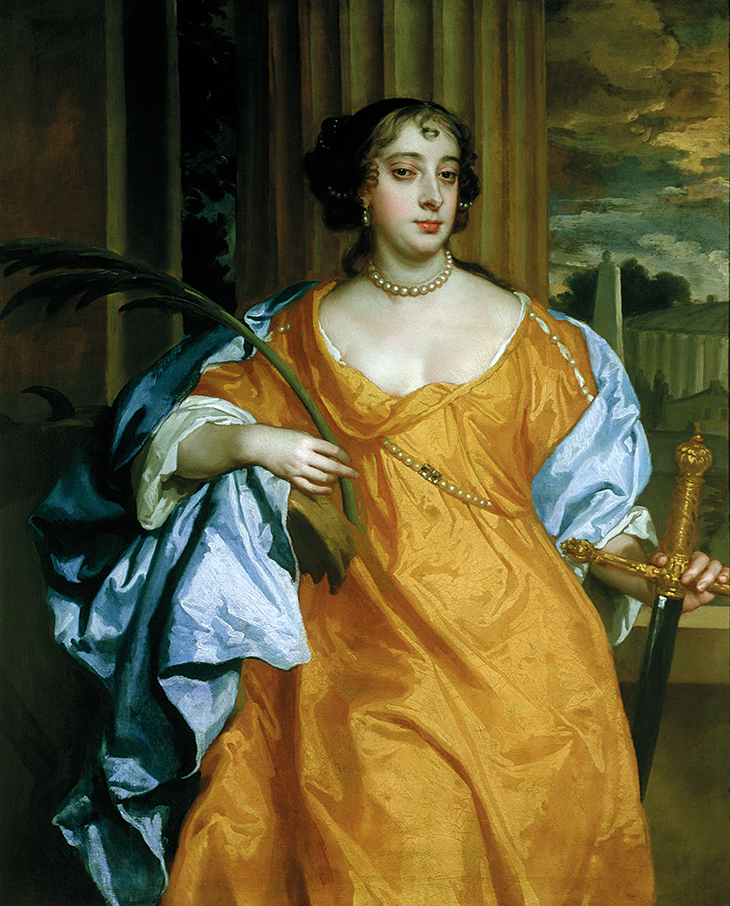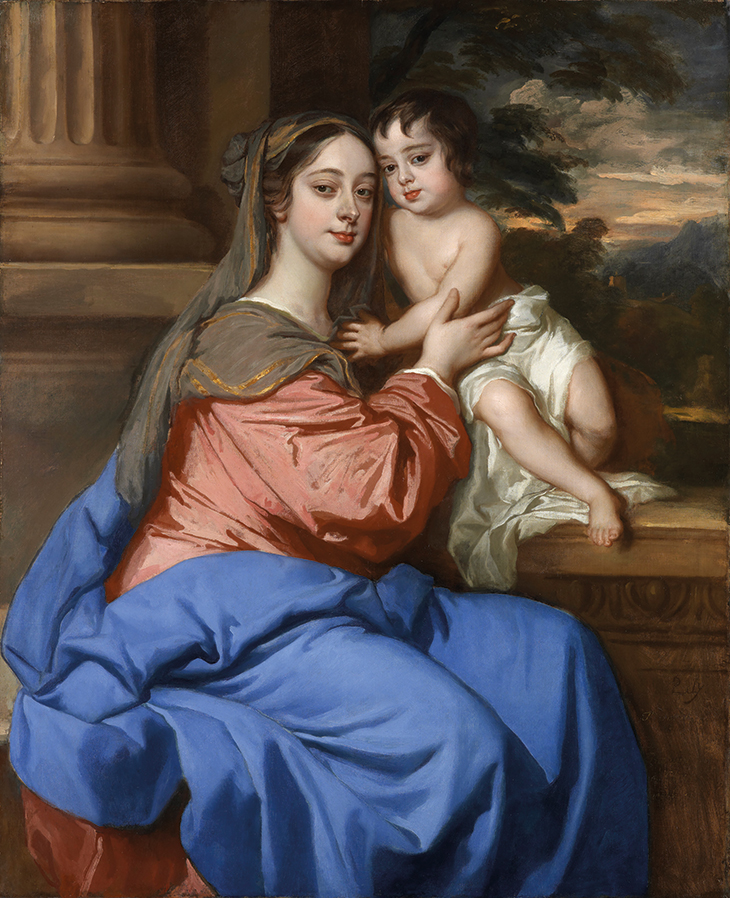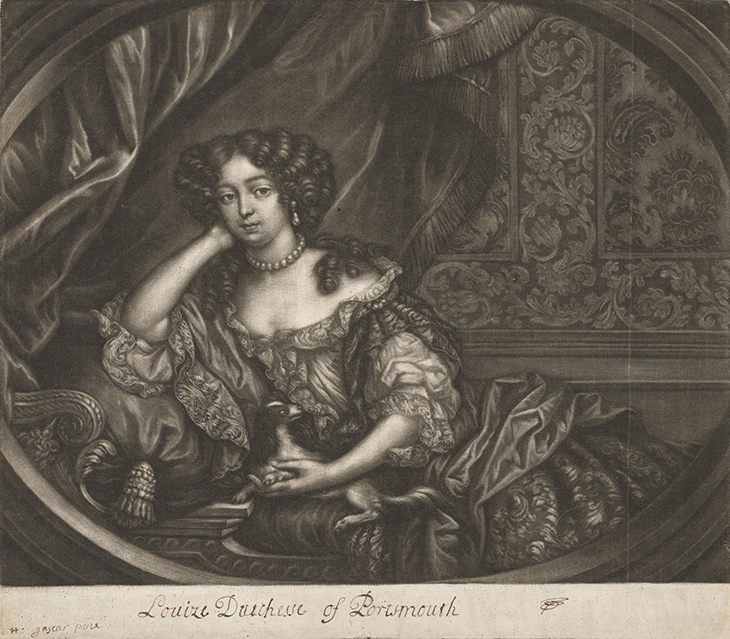William Sherwin’s engraving Barbara Dutchess of Cleaveland and Countess of Castlemaine etc (c. 1668–75) preserves a lost painting by Charles II’s Principal Painter, Peter Lely. The king’s favourite mistress during the 1660s is portrayed as a shepherdess, gazing idly at the viewer with a crook tucked under one arm and her left hand extended to stroke the top of a lamb’s head. Her long dark hair tumbles down to her waist and her head is framed by the halo of a vast hat in the same rich silken material as her robes.
Barbara Dutchess of Cleaveland and Countess of Castlemaine etc (c. 1668–75), William Sherwin. British Museum, London. Photo: The Trustees of the British Museum

The choice of setting and pastoral props appear generic and straightforward, but the idiosyncrasies of Lely’s composition – the pose, the robes, the hat, the hair – are far from innocent. The Countess of Castlemaine employed Lely mischievously to imitate a recent portrait by the Catholic court painter Jacob Huysmans, Catherine of Braganza (c. 1662–64), which shows Charles’s new queen richly attired in silvery robes and crowned with a dramatic purple hat. Her dark hair is loose to her waist; a shepherdess’s crook leans behind her and her hand rests on the head of a lamb as she looks out to meet the viewer’s gaze. Lely’s mirroring of the exaggerated pomp of Huysmans’ presentation would have been read as an open statement of competition, a demonstration that anything the queen could do, her rival could do likewise or better. The replication of symbols of fertility – blossoms, lambs – from Huysmans’ portrait must have seemed especially pointed given that, while the hopes of succession rested on Catherine, by the summer of 1662 Castlemaine had already given birth to a boy by the king.
Catherine of Braganza (c. 1662–64), Jacob Huysmans. Royal Collection Trust. Photo: Royal Collection Trust/HM Queen Elizabeth II 2020

Castlemaine’s Lely commission is a particularly naked example of the kind of political work that portraiture during the period was called upon to do. As shown by ‘British Baroque: Power and Illusion’, an exhibition that recently ran at Tate Britain, the monarch and his courtiers employed painters such as Lely and Huysmans strategically, seeking to create a visual mythology that would affirm their power and legitimacy. Portraits were used to establish political alliances and deepen factional divides; they were part of a culture of dazzling visual display meant to impress and intimidate. Few figures at court saw their potential or weaponised them as keenly as the king’s ‘official’ mistresses, for whom discrediting the claims of rivals and demonstrating intimacy with the monarch required persuasive tricks of presentation.
The future Countess of Castlemaine and Duchess of Cleveland, Barbara Villiers, married Roger Palmer in 1659 at the age of 18 and began her affair with Charles the following year, either shortly before or after he was restored to the throne in May 1660. Their first daughter, Anne, was born in February 1661. Charles demonstrated his partiality by insisting that his mistress be appointed as a lady of the bedchamber to the queen, ennobling her and providing her with her own apartments at the Palace of Whitehall. Her power was political as well as personal. Castlemaine used her position to help courtiers who paid her to attain ministerial roles, and by the late 1660s she was passing information to the French ambassador during treaty negotiations with Louis XIV. In 1670, however, her position at court was threatened by the arrival of Louise de Kéroualle, a 21-year-old French maid of honour who caught Charles’s eye and became his acknowledged mistress the following year. De Kéroualle was made Duchess of Portsmouth in 1673 and given a vast, lavishly decorated Whitehall apartment for herself and her children, which she turned into an unofficial point of access to the king for favoured courtiers and politicians. Her Catholicism and closeness to the French ambassador made her a figure of loathing among Protestant parliamentarians, who tried to force her out by issuing articles declaring her guilty of high treason and of meddling in domestic affairs by encouraging Charles to dissolve Parliament at key moments. She and the Duchess of Cleveland were attacked repeatedly in both print and manuscript, targeted by court satirists who wrote vicious defamatory lampoons that spread around Whitehall like wildfire. Fighting to regain control of their image, they employed sympathetic portraitists to launch visual propaganda campaigns of their own.
The genre favoured by baroque painters to aggrandise their high-born patrons was the historical grand style: large-scale portraits and murals that transformed contemporary monarchs, statesmen and military leaders into classical or biblical archetypes and positioned them within emblematic heroic narratives. Antonio Verrio’s The Sea Triumph of Charles II (c. 1674), for instance, imagines the king as Neptune bringing the calm seas of peace to a war-torn nation, his restoration to the throne linked allusively to the arrival of the all-powerful Augustus in Virgil’s Aeneid. William III was portrayed both as Augustus and Hercules, in paintings, statues and medals designed to emphasise his warrior-kingship, strength and courage. Women, meanwhile, whose chief praiseworthy attributes – fertility, beauty, virtue – could be captured by the use of small-scale symbolism within portraits rather than full-blown mythic or biblical allegory, were rarely the subjects of emblematic paintings in the grand style. But for the few who played active and politically influential roles at court, there was an evident double value in commissioning historical or biblical portraits – both because such portraits were an efficient means of projecting an image of power, and because they implied that their subjects were people who could live up to the grandeur and ambition of the genre.
Barbara Villiers, Duchess of Cleveland as St Catherine of Alexandria (c. 1665–70), Peter Lely. Private collection. Photo: Bridgeman Images

In the mid 1670s, the Italian Duchess of Mazarin arrived in England and embarked on a short-lived affair with the king. Around the time their involvement began she hired the court painter Benedetto Gennari to allegorise her newly powerful position. Gennari’s large-scale composition presents her as Diana, Roman goddess of the hunt: leader of the pack and mistress of all she surveys, she is shown defiantly bare-breasted with a spear in one hand and a quiver of arrows at her feet, surrounded by fawning dogs and black servant boys enslaved in neckcollars. The naked power-play of this portrayal was perhaps learnt from Cleveland, whom Lely painted in a series of aggrandising roles during the 1660s. Barbara Villiers, Duchess of Cleveland as St Catherine of Alexandria (c. 1665–70) depicts her as the Christian saint who was tortured and beheaded at the age of 18 by the 4th-century emperor Maxentius, after refusing to sacrifice her virginity to save her life. The St Catherine role wasn’t created for Cleveland: another noted court beauty, the Countess of Gramont, had been painted by Lely as the saint in c. 1663 around the time of her marriage, when the implied association with carefully guarded virginity would have been straightforward to read. In the case of the Cleveland picture, by contrast, the knowledge of everyone at court (and beyond, since portraits of the duchess were popularly reproduced) as to who Cleveland was meant that the Catherine overtones – the martyr’s palm in the sitter’s right hand, the beheading sword in her left – took on a knowingly ironic or defiant aspect, reinforced by the way the picture advertised the duchess’s seductive beauty.
Elizabeth Hamilton, Countess of Gramont (c. 1663), Peter Lely. Royal Collection Trust. Photo: Royal Collection Trust/HM Queen Elizabeth II 2020

For sheer brazenness, though, the St Catherine portrait seems easily outstripped now by another Lely commission of around 1664, which depicted Cleveland as the Madonna in Marian blue. Gazing innocently at the viewer, the duchess cradles her illegitimate son Charles Fitzroy, a cherubic figure already sporting the king’s dark curls. The picture’s casualness about the way it uses archetypes is unsettling. In its language the Holy Child is a bastard, God the Father is an unfaithful absent husband and the Madonna is a whore (and a fertile one, unlike the childless queen, who, the portrait implies, cannot even be impregnated by God). The composition is audacious because of the allegorical parallels it draws, but part of its audacity lies in the way it ridicules the pretensions and fictions of the genre it belongs to. No one in their right mind would think of Cleveland as the Virgin Mary; but if picturing her in this way is possible, then the appropriateness of Charles-as-Neptune or William-as-Hercules can be called into question too. Nothing is what it seems if the virgin is a whore.
Barbara Palmer (née Villiers), Duchess of Cleveland with her son, probably Charles Fitzroy, as the Virgin and Child (c. 1664), Peter Lely. National Portrait Gallery, London

Mazarin’s semi-nudity in the Diana portrait – her right breast exposed by the casual folds of her robes – is an important part of the picture’s statement about female power. Court etiquette during Charles’s reign required that any person in the presence of a superior should be formally dressed, while royals or courtiers receiving their inferiors could assert their position by appearing informally or in a state of partial undress. Mazarin’s loosened robes, much like Portsmouth’s gaping nightgown in Lely’s Louise de Kéroualle as a Shepherdess (c. 1671), would have been read as a double assertion of power: as both a sexual provocation and a political one, a claim about the relative status of the viewer who would find his gaze first solicited and then humbled. Everyone – even, or perhaps especially, the king – was meant to feel that these were women who felt no need to present themselves fully dressed.
Louise de Kéroualle as a Shepherdess (c. 1671), Peter-Lely. Althorp, Northamptonshire

Contemporaries found this form of self-aggrandisement infuriating, but its obverse was perceived as just as provocative. Lavishness of dress and conspicuous personal display was one powerful weapon the royal mistresses could exercise to signal their intimacy with the monarch, since it was clear to everyone who paid the bills. Lely’s mischievous portrait of Cleveland as a shepherdess imitates and upstages the rich metallic sheen of Catherine of Braganza’s dress in Huysmans’ painting, just as in real life both Cleveland and Portsmouth took pleasure in outshining the queen whenever they could at state functions. Henri Gascar’s mezzotint Portrait of Louise de Kéroualle, Duchess of Portsmouth (c. 1675), likewise, makes unsubtle reference to the duchess’s position at court by picturing her with a King Charles spaniel nuzzling the front of her nightgown, but also establishes her power through the sumptuous swags of velvet canopying her day-bed and the intricate tapestry on the wall behind her. Hostile court satirists saw the visible expensiveness of Charles’s mistresses as a possible way of turning opinion against them and sought to represent their luxury as a drain on the finances of the nation. ‘Why art thou poor, O King?’ asked the anonymous author of ‘An Essay of Scandal’ (1681) rhetorically. ‘Remove that costly dunghill [Cleveland] from thy doors; / If thou must have ’em, use cheap, wholesome whores.’ The author of ‘On the D—ss of P—th’s PICTURE, September 1682’ went one step further and attacked Portsmouth for not being attractive enough to justify all the money: ‘Who can on this Picture look, / And not strait be Wonder strook, / That such a peaking doudy Thing / Should make a Beggar of a King?’
Portrait of Louise de Kéroualle, Duchess of Portsmouth (c. 1675), attributed to Henri Gascar. British Museum, London. Photo: The Trustees of the British Museum

Following Horace’s doctrine of ut pictura poesis, a number of court satires treated portraits as sister art forms, available to draw on to illustrate an argument or help visualise an idea. The popular ‘advice to a painter’ genre of verse, which could be used for either satirical or panegyric purposes, put its slant on contemporary politics by instructing an imaginary painter how to depict a particular event or person. Edmund Waller’s Instructions to a Painter (1665), for instance, uses the conceit to praise the Duke of York’s recent victory over the Dutch at Lowestoft, instructing his artist to ‘Paint an east wind, and make it blow away / Th’ excuse of Holland for their navy’s stay; / Make them look pale.’ Andrew Marvell’s manuscript-circulated responses to Waller, by contrast, issue his painter with satirical instructions to show up the ineptitude and cowardice of the courtiers in charge of the English ships. ‘Canst thou paint without Colours? Then ’tis right: / For so we too without a Fleet can fight.’ A favourite trick of the ‘advice’ poems was to take inspiration from portraiture’s economical use of symbols to represent abstract ideas or narratives. In Waller’s poem, the figure of the Duke of York stands in for the English nation and the royal bloodline he defends, as ‘the bulwark of his native land’. In Marvell’s Third Advice to a Painter (1666), less flatteringly, Prince Rupert’s venereal disease is grotesque shorthand for his person and character: ‘Jove in one cloud did scarcely ever wrap / Lightning so fierce, but never such a clap!’
Royal mistresses, whose power came from their sexuality, were represented in court lampoons by the body parts that seemed to encapsulate their position and abilities, in a manner that both referenced and travestied portraiture’s reliance on visual iconography. Since satirists didn’t always dare to name their targets outright, the availability of a widely understood shorthand language was key to the intelligibility of their pieces. The Earl of Rochester’s ‘Signior Dildo’ (1673), for instance, makes no distinction between Cleveland and the part of her body (‘it’) that does the work she is famous for: ‘That pattern of virtue, her Grace of Cleveland, / Has swallowed more pricks than the nation has land; / But by rubbing and scrubbing so large it does grow / It is fit for just nothing but Signior Dildo.’
The anonymous ‘Lampoon’ (1676), likewise, makes one significant part of Cleveland’s body the agent of the whole (‘The cunt that first had raised her / Was now the cause of her fall’); while ‘An Essay of Scandal’, with particular venom, uses Portsmouth’s genitalia as both a synecdoche for her person and a metaphor for the financial black hole she has become for the king: ‘Embezzling cunt, / That wide-mouthed, greedy monster.’ Charles himself wasn’t spared the shorthand treatment, caricatured as ‘the sauciest prick that e’er did swive, / The proudest, peremptoriest prick alive’. ‘Poor Prince!’ exclaims Rochester in ‘A Satyr on Charles II’, ‘thy prick, like thy buffoons at Court, / Will govern thee because it makes thee sport.’
Charles’s critics were afraid of the ‘governing’ power of his sexual appetite because it put his mistresses in charge. Some articulated this fear by making a metaphorical connection between the king’s penis and his royal sceptre: any woman who had control of the former, it was believed, might also exert control over the latter. ‘His Scepter and his Prick are of a length; / And she may sway the one who plays with th’ other.’ The metaphor was meant to cast suspicion on the political intentions of the mistresses and paint as unnatural a sexual relationship in which a female dominated over her social superior. But in sympathetic hands it could be deployed in another direction. Lely’s paintings of Cleveland and Portsmouth as shepherdesses holding crooks – along with Gennari’s portrait of Mazarin with a spear – incorporate translated versions of the sceptre emblem in allegories of female power, the sitter in each case gazing assertively at the viewer with her prop held erect, seeking to confirm the worst fears of her political opponents. As with Lely’s portrait of Cleveland as the Madonna, or Gascar’s of Portsmouth with her nuzzling King Charles spaniel, the use of visual shorthand is provocative and challenging. Caricatured by their enemies, Charles’s mistresses used portraiture to reclaim for their own propaganda the symbols that were meant to limit them.
From the March 2020 issue of Apollo. Preview and subscribe here.


